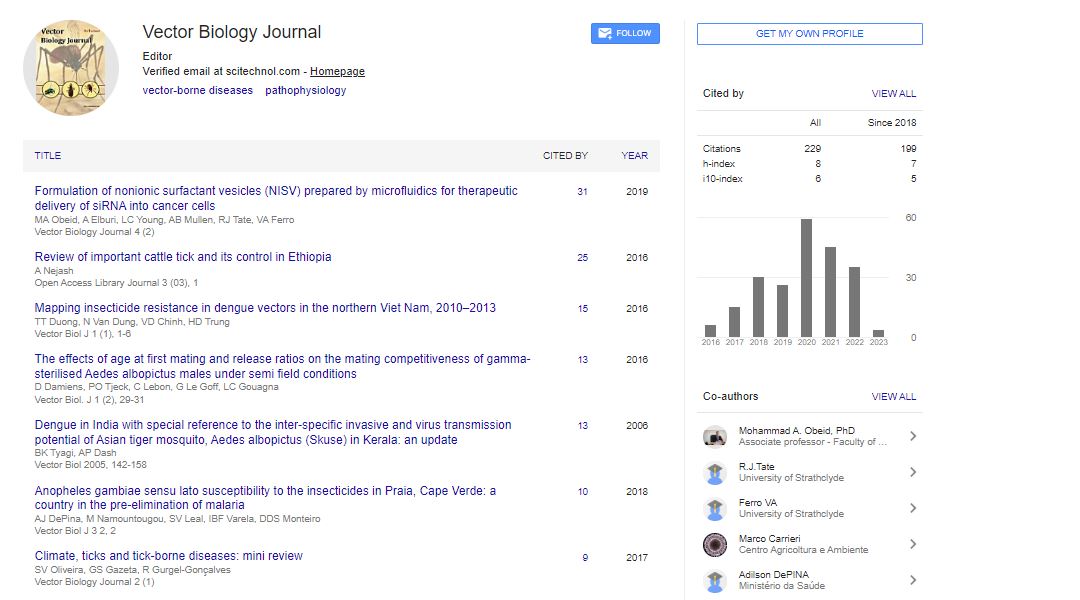Commentary, Vector Biol Vol: 8 Issue: 2
The Global Impact of Dengue Fever: A Comprehensive Analysis
Cheung Lee*
1Department of Human Health, South China University of Technology, Guangzhou, China
*Corresponding Author: Cheung Lee,
Department of Human Health, South China
University of Technology, Guangzhou, China
E-mail: leecheung9700129@edu.cn
Received date: 30 May, 2023, Manuscript No. VBJ-23-107291;
Editor assigned date: 02 June, 2023, PreQC No. VBJ-23-107291 (PQ);
Reviewed date: 16 June, 2023, QC No. VBJ-23-107291;
Revised date: 23 June, 2023, Manuscript No. VBJ-23-107291 (R);
Published date: 30 June, 2023 DOI: 10.4172/2473-4810.1000263
Citation: Lee C (2023) The Global Impact of Dengue Fever: A Comprehensive Analysis. Vector Biol 8:2.
Description
Dengue fever is a viral disease transmitted by the Aedes mosquito, primarily in tropical and subtropical regions. It poses a significant global health challenge, affecting millions of people each year. This research aims to provide an overview of dengue fever, including its transmission, symptoms, diagnosis, prevention, and treatment. By understanding the intricacies of this disease, we can enhance our efforts in combating its spread and minimizing its impact on public health.
Dengue fever is primarily transmitted to humans through the bite of infected Aedes mosquitoes, particularly Aedes aegypti and Aedes albopictus. These mosquitoes are commonly found in urban and semiurban areas, breeding in stagnant water sources such as water storage containers, discarded tires, and flower pots. The disease is not directly contagious from person to person.
Symptoms and clinical manifestations
Following an incubation period of 4 to 10 days, individuals infected with dengue virus may experience a wide range of symptoms. These symptoms can range from mild to severe and include high fever, severe headache, joint and muscle pain, rash, fatigue, and eye pain. In some cases, the disease may progress to a severe form known as Dengue Hemorrhagic Fever (DHF) or Dengue Shock Syndrome (DSS), which can be life-threatening.
Diagnosis and laboratory testing
Prompt and accurate diagnosis is crucial for managing dengue fever effectively. Diagnostic tests for dengue include the detection of the virus itself (using Reverse Transcription-Polymerase Chain Reaction, or RT-PCR) or antibodies produced by the infected person's immune system (using Enzyme-Linked Immunosorbent Assay, or ELISA). Rapid diagnostic tests are also available for quick detection in resource-limited settings.
Prevention strategies
Given the absence of specific antiviral treatment or vaccine, prevention plays a vital role in controlling the spread of dengue fever. Effective prevention strategies involve targeting the mosquito vector and reducing human-mosquito contact. This includes eliminating breeding sites by emptying stagnant water containers, using mosquito nets and screens, wearing protective clothing, and applying mosquito repellents. Community engagement and education campaigns are essential for raising awareness about dengue and promoting preventive measures.
Treatment and management
While there is no specific antiviral treatment for dengue fever, supportive care is crucial for managing the disease. This includes rest, fluid replacement to prevent dehydration, and medication to reduce fever and pain. Patients with severe dengue may require hospitalization and close monitoring to detect any signs of organ impairment or shock. Early detection and access to medical care significantly improve patient outcomes.
Global impact and challenges
Dengue fever has become a major public health concern globally, affecting over 100 countries and threatening nearly half of the world's population. The disease places a significant burden on healthcare systems, economies, and the well-being of affected individuals and communities. Climate change, urbanization, increased international travel, and inadequate mosquito control programs contribute to the growing challenge of dengue prevention and control.
Dengue fever remains a global health challenge with substantial public health implications. By adopting integrated approaches that combine vector control, community engagement, and public awareness campaigns, we can mitigate the spread of dengue and reduce its impact. Additionally, continued research and innovation in vaccine development and vector control strategies are essential in the fight against this mosquito-borne disease.
 Spanish
Spanish  Chinese
Chinese  Russian
Russian  German
German  French
French  Japanese
Japanese  Portuguese
Portuguese  Hindi
Hindi 